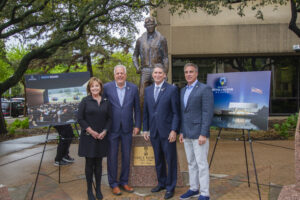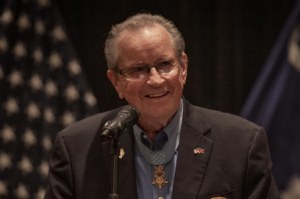
December 7, 1941, was the attack on Pearl Harbor and the date that led America to enter World War II. That tragic morning at 7:48 a.m., 353 Imperial Japanese aircrafts attacked the Pearl Harbor Naval Base on Oahu Island in Hawaii. This attack damaged or sank eighteen U.S. ships including all eight U.S. Navy battleships and destroyed another 188 U.S. aircrafts. The gruesome reality of the attack was in the number of military personnel and civilian casualties. Ninety minutes after the attack began, it was over, with 2,335 American military personnel killed and another 1,143 wounded. 68 civilians were also killed, and 103 civilians were injured.
Sixteen men, fifteen from the U.S. Navy and one from the U.S. Marines, were awarded the Medal of Honor for their actions on the day of the attack on Pearl Harbor, eleven of them were awarded posthumously. These men were brave and heroic when faced with a calculated surprise attack and truly put service above self as they saved many lives and US watercraft.
Mervyn S. Bennion*, Captain
As Commanding Officer of the USS West Virginia, after being mortally wounded, Capt. Bennion evidenced apparent concern only in fighting and saving his ship, and strongly protested against being carried from the bridge.
John W. Finn, Lieutenant
Lt. Finn promptly secured and manned a .50-caliber machinegun mounted on an instruction stand in a completely exposed section of the parking ramp, which was under heavy enemy machinegun strafing fire. Although painfully wounded many times, he continued to man this gun and to return the enemy’s fire vigorously and with telling effect throughout the enemy strafing and bombing attacks and with complete disregard for his own personal safety.
Francis C. Flaherty*, Ensign
When it was seen that the USS Oklahoma was going to capsize and the order was given to abandon ship, Ens. Flaherty remained in a turret, holding a flashlight so the remainder of the turret crew could see to escape, thereby sacrificing his own life.
Samuel G. Fuqua, Lieutenant
Knocked unconscious from the bombing of the USS Arizona, he regained consciousness and began directing the fighting of fires and the rescue of wounded and injured personnel. His calm and cool manner and with excellent judgement inspired everyone who saw him and resulted in the saving of many lives. After realizing the ship could not be saved and that he was the senior surviving officer aboard, he directed it to be abandoned, but continued to remain on the quarterdeck and directed abandoning ship and rescue of personnel until satisfied that all personnel that could be had been saved, after which he left his ship with the boatload.
Edwin J. Hill*, Lieutenant
During the height of the strafing and bombing, Chief Boatswain Hill led his men of the linehandling details of the USS Nevada to the quays, cast off the lines and swam back to his ship. Later, while on the forecastle, attempting to let go the anchors, he was blown overboard and killed by the explosion of several bombs.
Herbert C. Jones*, Ensign
Ens. Jones organized and led a party, which was supplying ammunition to the antiaircraft battery of the USS California after the mechanical hoists were put out of action when he was fatally wounded by a bomb explosion. When two men attempted to take him from the area which was on fire, he refused to let them do so, saying in words to the effect, “Leave me alone! I am done for. Get out of here before the magazines go off.”
Isaac C. Kidd*, American Rear Admiral
Adm. Kidd immediately went to the bridge and, as Commander Battleship Division One, courageously discharged his duties as Senior Officer Present Afloat until the USS Arizona, his Flagship, blew up from magazine explosions and a direct bomb hit on the bridge which resulted in the loss of his life.
Jackson C. Pharris, Lieutenant Commander
In charge of an ordnance repair party on the USS California, he was severely injured and unconscious but recovered to act on his own initiative to set up a hand-supply ammunition train for the antiaircraft guns and ordered the shipfitters to counterflood. He was twice rendered unconscious by the nauseous fumes and handicapped by his painful injuries, he persisted in his desperate efforts to speed up the supply of ammunition and at the same time repeatedly risked his life to enter flooding compartments and drag to safety unconscious shipmates who were gradually being submerged in oil. He saved many shipmates from death and is largely responsible for keeping the California in action during the attack.
Thomas J. Reeves*, Chief Petty Officer
After the mechanized ammunition hoists were put out of action in the USS California, Reeves, on his own initiative, in a burning passageway, assisted in the maintenance of an ammunition supply by hand to the antiaircraft guns until he was overcome by smoke and fire, which resulted in his death.
Donald K. Ross, Machinist
When his station in the forward dynamo room of the USS Nevada became almost untenable due to smoke, steam, and heat, Machinist Ross forced his men to leave that station and performed all the duties himself until blinded and unconscious. Upon being rescued and resuscitated, he returned and secured the forward dynamo room and proceeded to the after-dynamo room where he was later again rendered unconscious by exhaustion. Again, recovering consciousness, he returned to his station where he remained until directed to abandon it.
Robert R. Scott*, Machinist’s Mate First Class
The compartment, in the USS California, in which the air compressor, to which Scott was assigned as his battle station, was flooded as the result of a torpedo hit. The remainder of the personnel evacuated that compartment, but Scott refused to leave, saying words to the effect “This is my station and I will stay and give them air as long as the guns are going.”
Peter Tomich*, Chief Watertender
Although realizing that the ship was capsizing, as a result of enemy bombing and torpedoing, Tomich remained at his post in the engineering plant of the USS Utah, until he saw that all boilers were secured, and all fireroom personnel had left their stations, and by so doing lost his own life.
Franklin Van Valkenburgh*, Captain
As Commanding Officer of the USS Arizona, Capt. Van Valkenburgh gallantly fought his ship until the USS Arizona blew up from magazine explosions and a direct bomb hit on the bridge which resulted in the loss of his life.
James R. Ward*, Seaman Recruit
When it was seen that the USS Oklahoma was going to capsize, and the order was given to abandon ship, Ward remained in a turret holding a flashlight, so the remainder of the turret crew could see to escape, thereby sacrificing his own life.
Cassin Young, Captain
As Commanding Officer of the USS Vestal, during the attack on the Fleet in Pearl Harbor, Territory of Hawaii, by enemy Japanese forces on 7 December 1941. Comdr. Young proceeded to the bridge and later took personal command of the 3-inch antiaircraft gun. When blown overboard by the blast of the forward magazine explosion of the USS Arizona, to which the USS Vestal was moored, he swam back to his ship. The entire forward part of the USS Arizona was a blazing inferno with oil afire on the water between the 2 ships; as a result of several bomb hits, the USS Vesta was on fire in several places, was settling and taking on a list. Despite severe enemy bombing and strafing at the time, and his shocking experience of having been blown overboard, Comdr. Young, with extreme coolness and calmness, moved his ship to an anchorage distant from the USS Arizona, and subsequently beached the USS Vestal upon determining that such action was required to save his ship.
George H. Cannon*, First Lieutenant, U.S. Marines
First Lieutenant Cannon was at his command post when he was mortally wounded by enemy shellfire. He refused to be evacuated from his post until after his men who had been wounded by the same shell were evacuated and directed the reorganization of his command post until forcibly removed. As a result of his utter disregard of his own condition he died from loss of blood.

National Medal of Honor Museum Foundation Announces Naming of Colonel Neel Kearby Theater During National Medal of Honor Day Celebration
Museum Foundation leadership partnered with City of Arlington, Texas to pay tribute to local Medal of Honor recipient and kick off Museum’s one-year ‘March to Grand Opening’ countdown .


